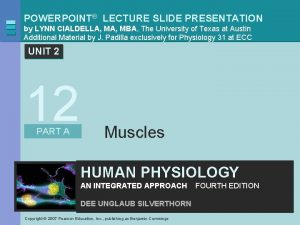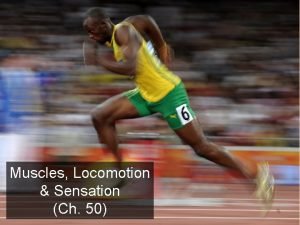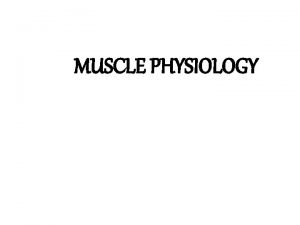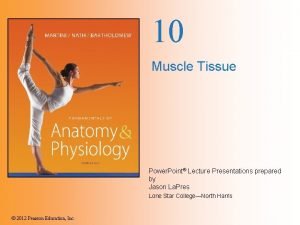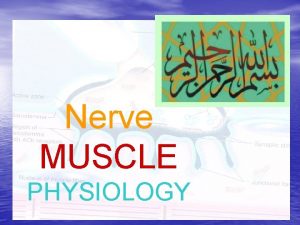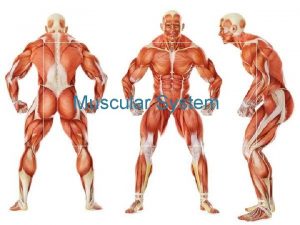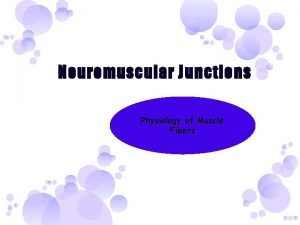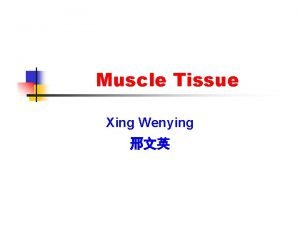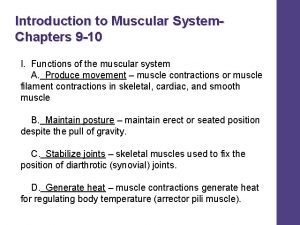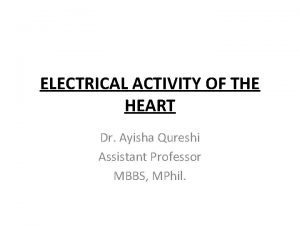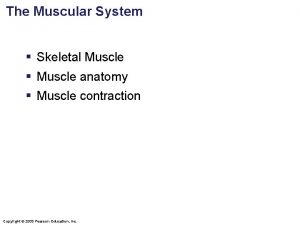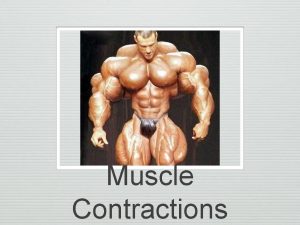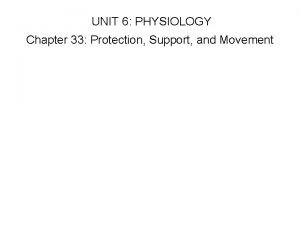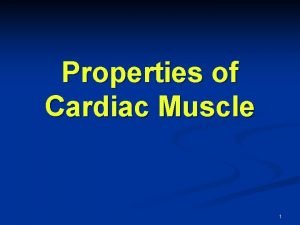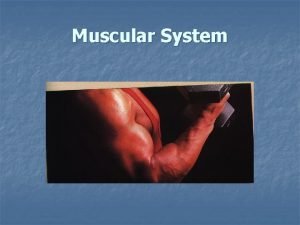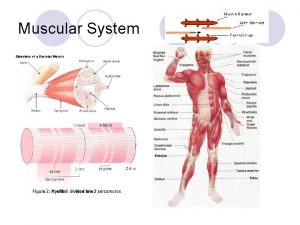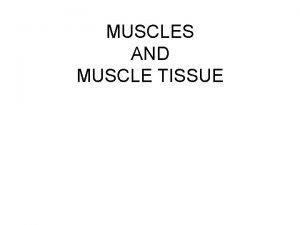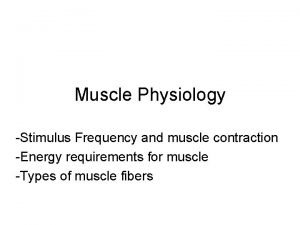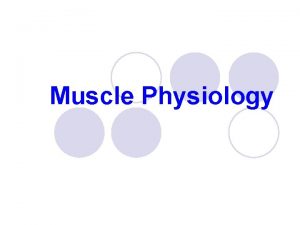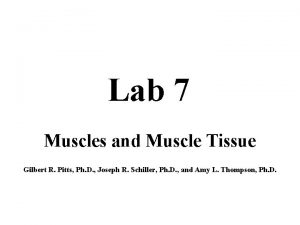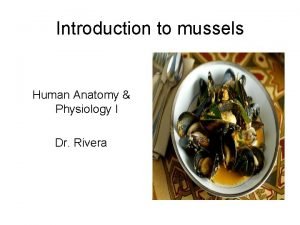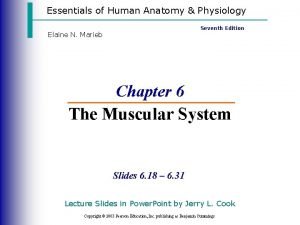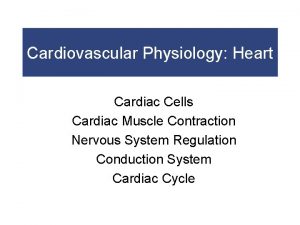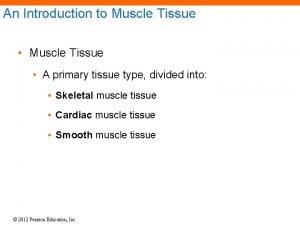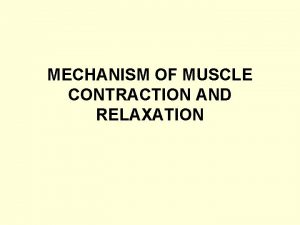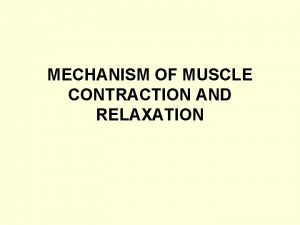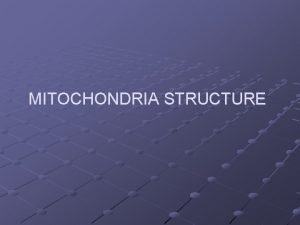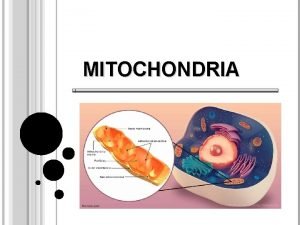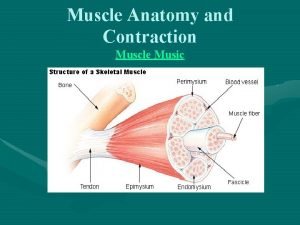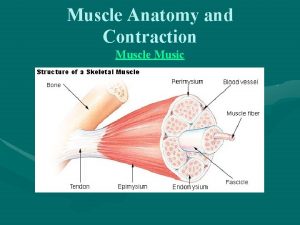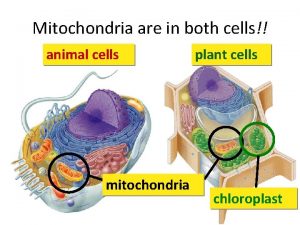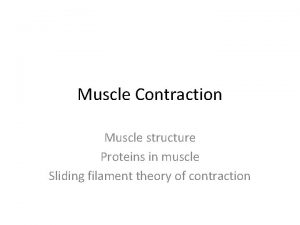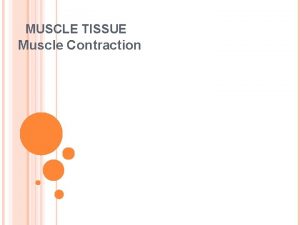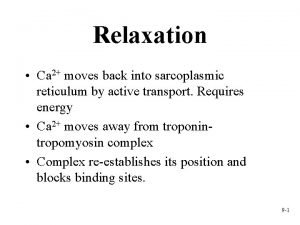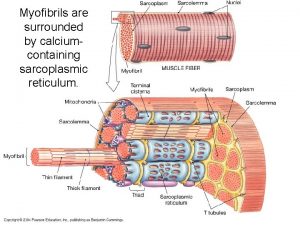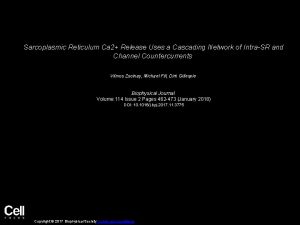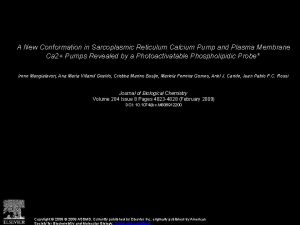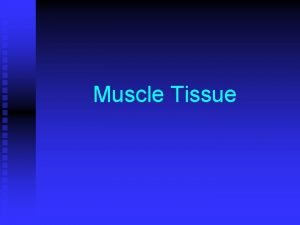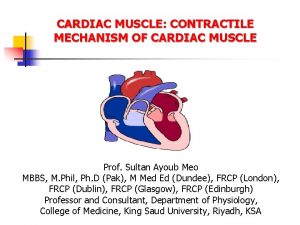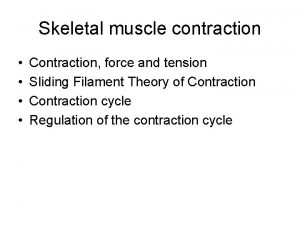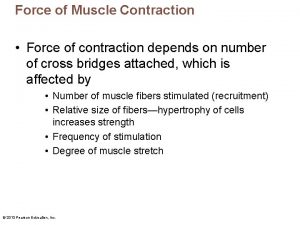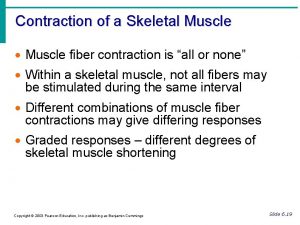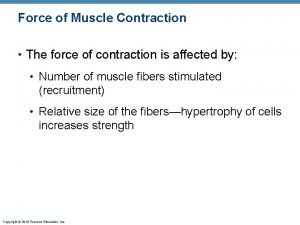Muscle Cells and Contraction mitochondria sarcoplasmic reticulum contractile






























- Slides: 30

Muscle Cells and Contraction mitochondria sarcoplasmic reticulum contractile filaments

Muscle Types • Type I - “Red”, “Slow” – Contracts relatively slowly – Many mitochondria – Good blood supply • Type IIb - “White”, Fast” – Contracts relatively rapidly – Few mitochondria – Poor blood supply – Packed full of contractile filaments

Gentle exercise • Type I muscles recruited – good blood supply, heaps of mitochondria • Most readily available fuel is glucose – Glucose transporters move to cell surface BLOOD MUSCLE glucose Transporters

Consequences of Glucose Usage • Muscle glucose uptake leads to a decrease in blood glucose concentration • Need to keep blood glucose constant! – Small change in blood glucose causes. . . insulin glucagon

Effects of Low Insulin and High Glucagon – Stimulation of glycogen breakdown in liver – Stimulation of fat breakdown in white adipose tissue LIVER WAT GLYCOGEN FAT glucose fatty acids glucose

Glucose Recycling • Glucose stores (glycogen) are limited – Cannot convert fatty acids into glucose • GLUCOSE CONSERVATION AND RECYCLING – Fatty acids substitute for glucose as a fuel – Fatty acids prevent glucose from being wastefully oxidised

Fatty Acid and Glucose Oxidation glucose GLYCOLYSIS pyruvate fatty acids FATTY ACID OXIDATION acetyl Co. A CO 2

Fatty Acid Oxidation inhibits Glucose Oxidation glucose to liver GLYCOLYSIS inhibits pyruvate fatty acids FATTY ACID OXIDATION acetyl Co. A CO 2 lactate

Summary of Gentle Exercise – Initially, glucose is used – Then fatty acids take over and glucose is recycled LIVER GLYCOGEN lactate MUSCLE glucose WAT FAT glucose lactate CO 2 fatty acids CO 2

Moderate Exercise • As the pace increases, the rate of fatty acid utilisation increases, but. . – The enzymes that catalyse fatty acid oxidation soon reach their maximum capacity – During running, fatty acid oxidation alone is not sufficient to maintain ATP production – Inhibition on glucose oxidation is removed • Glucose oxidation occurs! • Less glucose recycling • Liver glycogen stores depleted faster

Summary of Moderate Exercise LIVER GLYCOGEN lactate MUSCLE glucose WAT FAT fatty acids glucose fatty acids lactate CO 2

Strenuous Exercise – As the intensity of the exercise increases further, muscle glycogen is broken down. LIVER GLYCOGEN lactate glucose WAT FAT fatty acids MUSCLE GLYCOGEN glucose fatty acids CO 2

Glycogen Depletion during a Marathon Race Glycogen (mg/g) 100 75 slower 50 25 faster 0 0. 5 1. 0 1. 5 2. 0 Time (hours) 2. 5

Why Glycogen is Important • When glycogen has run out, only fatty acid oxidation can be used for ATP generation • Power output is lower when using only fatty acids • “Hitting the Wall” • Cannot sprint if there’s no glycogen

Strategies • Start the event with more glycogen than your competitors • Spare the glycogen by making more use of fatty acids • Use fatty acids sooner so less glycogen is used in the early stages

Glycogen Supercompensation – After extensive depletion, glycogen resynthesis overshoots. 100 75 50 pre-exercise level 25 0 0 1 2 3 Time (days) 4 5

Glycogen Loading - Classical 100 – Interrupts training! – Potentially dangerous – Uncomfortable – Character building! 75 50 Hi. FAT Hi. CHO 25 0 0 1 2 3 Time (days) 4 5

Glycogen Loading - Tapered • Fits well into normal training • No dangerous full glycogen depletion. 100 75 50 always High Carbohydrate 25 0 0 1 2 3 Time (days) 4 5

Glycogen Sparing • Increase the use of fatty acids – Carnitine helps fatty acids enter mitochondria – Training increases the activity of fatty acid oxidation enzymes • Start fatty acid release from White Adipose Tissue early – Strong cup of coffee! – NOT glucose drinks BEFORE an event insulin glucagon = inhibition of fatty acid release

Fitness • Better cardiovascular system • Increased vascularisation of muscles – better oxygen supply – better fuel supply (especially fatty acids) • More mitochondria – Higher capacity to burn fatty acids • Conversion of Type IIb to Type I?

Sprinting • Uses Type IIb muscles – Poor blood supply – Packed full of contractile filaments – Few mitochondria – VERY rapid consumption of ATP • Fuel selection problem – Fatty acids? » oxygen supply, mitochondria – Blood Glucose? » transporter recruitment, blood supply

Anaerobic Glycogen Utilisation GLYCOGEN GLYCOLYSIS ADP ATP pyruvate lactate to blood stream acetyl Co. A • Inefficient and incomplete • High turnover • Accumulation of lactate • Takes time to stimulate glycogen breakdown

Buying time with Creatine Phosphate creatine phosphate + ADP ® ATP + creatine • Less than 5 seconds supply of creatine phosphate – Enough to get glycogen mobilisation going • Adrenaline stimulates massive glycogen breakdown.

Fatigue • Role of lactate? ? • Acidity interferes with many processes – Enzymes involved in glycolysis – Contractile process – Calcium movements • All very controversial! – But one things for sure: very low p. H and running out of glycogen are definitely bad news – OK, so that was TWO things…

Fatigue 2 • Use p. H buffers? – Bicarbonate widely used – Certainly works but check with doctor first! • Does glycogen ever run out in a sprint? – Not in short events (100 m) – Important in longer events and multi-heat competitions

Does Glycogen run out during Sprinting? 100 • Have to ensure adequate glycogen resynthesis between races • Rapidly absorbed carbohydrate 75 50 25 depleted 0 0 1 2 3 Time (hours) 4 5

Sprint Training • Increased power output – Increased cell size – More contractile filaments – STEROIDS! • Co-ordination • Conversion of Type I to Type IIb? • Adequate glycogen stores

Lessons • Muscle Contraction – Muscle Types • Getting energy from fat and carbohydrate – No work, no energy consumption! – Increase work, increased oxidation of fuel • Fuel mix during. . – Walking, Jogging, Running and Sprinting • Training effects

How the Fuel Mix Changes LIGHT INTENSE Fatty acids CO 2 Glucose CO 2 Glycogen lactate MODERATE Fatty acids CO 2 Glucose CO 2 SPRINTING Creatine P creatine Glycogen lactate

Take Home Message! • Glycogen is an important fuel to all athletes – Using fatty acids quickly and copiously reduces the use of valuable glycogen • Carbohydrate intake has to be high to allow adequate glycogen synthesis
 Fusiform smooth muscle
Fusiform smooth muscle Transverse tubules and sarcoplasmic reticulum
Transverse tubules and sarcoplasmic reticulum T tubules
T tubules T tubules and sarcoplasmic reticulum
T tubules and sarcoplasmic reticulum Perimysium
Perimysium Cardiac troponin t antibody
Cardiac troponin t antibody Sarcoplasmic reticulum
Sarcoplasmic reticulum All or none principle of action potential
All or none principle of action potential Where are transverse tubules located
Where are transverse tubules located Sarcoplasmic reticulum
Sarcoplasmic reticulum Action potential in contractile cells
Action potential in contractile cells Muscle bundle
Muscle bundle Microscopic anatomy of skeletal muscle figure 6-2
Microscopic anatomy of skeletal muscle figure 6-2 Atp and muscle contraction
Atp and muscle contraction Cardiac muscle mitochondria
Cardiac muscle mitochondria Whats passive transport
Whats passive transport Latent period in muscle contraction
Latent period in muscle contraction Muscle system
Muscle system Types of muscle contraction
Types of muscle contraction Simple muscle twitch graph
Simple muscle twitch graph Whole muscle contraction
Whole muscle contraction Muscle physiology
Muscle physiology Sliding filament theory worksheet
Sliding filament theory worksheet Muscle tissue
Muscle tissue Isotonic isometric
Isotonic isometric Muscle contraction animation mcgraw hill
Muscle contraction animation mcgraw hill Incomplete tetanus muscle contraction
Incomplete tetanus muscle contraction Tetanus vs summation
Tetanus vs summation Muscle refractory period
Muscle refractory period Titin
Titin Frank starling law
Frank starling law

